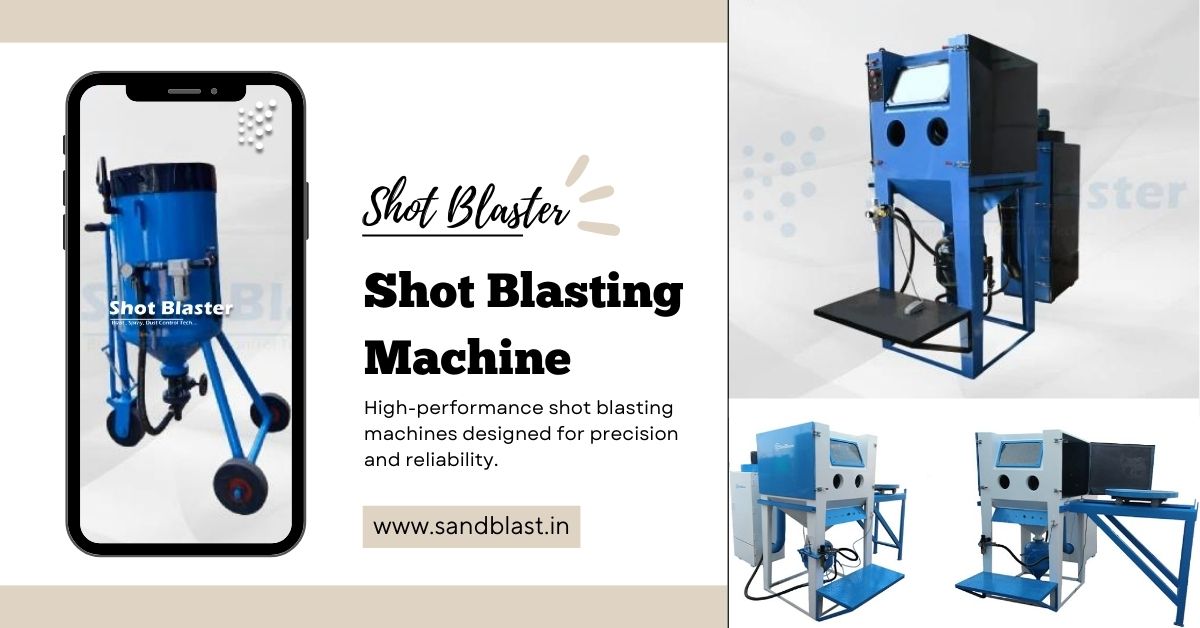Future Trends in Shot Blasting Machine Technology

Explore the latest trends in shot blasting machine technology, including automation, energy efficiency, robotics, and data-driven innovations for the future of surface preparation.
Introduction
The shot blasting industry is constantly evolving, with manufacturers and users alike seeking more efficient, precise, and environmentally sustainable solutions. As technological advancements continue to shape industrial processes, shot blasting machines are becoming smarter, more energy-efficient, and more adaptable.
This article explores the future trends in portable shot blasting machine technology, highlighting key innovations that promise to revolutionize surface preparation.
I. Rise of Automation in Shot Blasting Machines
- Automated Shot Blasting Systems Automated shot blasting systems have transformed the way industrial surface preparation is carried out. These systems allow for consistent and repeatable results with minimal human intervention. With automation, manufacturers can achieve higher throughput, ensuring both quality and efficiency are maintained in high-volume production environments.
- Integration with IoT (Internet of Things) The IoT is enabling the creation of smart shot / sand blasting machines that can be monitored remotely. This connectivity allows for real-time data analysis, machine diagnostics, and performance optimization, ensuring operations are always running at peak efficiency. Predictive maintenance also helps reduce downtime by forecasting potential issues before they arise.
II. Energy-Efficient Shot Blasting Machines
- Energy-Efficient Motor Technologies As energy consumption is a significant operational cost, manufacturers are increasingly turning to energy-efficient motors. These motors use less power, helping to reduce the overall electricity costs while maintaining the same level of performance. Over time, these savings can significantly offset the initial investment in new machinery.
- Advanced Dust Collection Systems Modern dust collection systems are designed to be more energy-efficient, using less power while maintaining superior air quality standards. These systems are critical for ensuring that shot blasting operations comply with environmental regulations, particularly in industries that deal with hazardous materials.
III. Incorporation of Robotics in Shot Blasting
- Robotic Arms for Precision Blasting Robotic arms in shot blasting systems offer unmatched precision, making them ideal for handling delicate or intricate parts. These robots can adjust their movements with high accuracy, ensuring uniform coverage without risking damage to the workpiece.
- Collaboration Between Robots and Humans While robots handle the bulk of the repetitive tasks, human operators oversee the process to ensure everything runs smoothly. This collaboration boosts productivity, enhances quality control, and enables workers to focus on more complex tasks that require human judgment.
Explore more - https://678f36490780c.site123.me/news/understanding-the-shot-blasting-process-and-its-benefits
IV. Advanced Materials for Shot Blasting Machines
- High-Strength Wear-Resistant Components The longevity of shot blasting machines depends heavily on the materials used in their construction. Advanced wear-resistant components, such as carbide-coated parts and reinforced steel, minimize the effects of abrasive blasting, ensuring that machines operate longer and require less frequent maintenance.
- Corrosion-Resistant Materials In industries where exposure to corrosive environments is common, such as in marine or chemical processing, corrosion-resistant materials are essential. According to Shot Blaster, these materials ensure the machine can withstand harsh conditions without compromising performance or safety.
V. Customization and Flexibility in Shot Blasting Machines
- Modular Design for Customization A modular design allows for machines to be tailored to specific tasks and industries. Users can easily modify or upgrade their systems as needs evolve, avoiding the need for a complete overhaul. This flexibility provides long-term value by adapting to the changing demands of production.
- Flexible Machine Settings Adjustable settings such as blast pressure, media flow, and speed enable users to optimize their shot blasting machines for different workpieces and materials. This versatility ensures that operators can achieve the desired finish for a wide range of applications.
VI. Data-Driven Technologies in Shot Blasting
- Machine Performance Monitoring Modern shot blasting machines are equipped with sensors that track various performance metrics. This data is collected and analyzed to ensure that the machine operates at peak efficiency. This real-time feedback allows for adjustments to be made immediately, preventing issues before they affect productivity.
- Predictive Maintenance Models Predictive maintenance is revolutionizing machine upkeep. By analyzing historical performance data, predictive algorithms can forecast potential failures, allowing operators to schedule maintenance before problems occur. This proactive approach significantly reduces unplanned downtime and repair costs.
Browse more - https://678f36490780c.site123.me/news/shot-blasting-machines-for-surface-cleaning-and-finishing
VII. Impact of Industry 4.0 on Shot Blasting Technology
- Smart Factories and Shot Blasting Machines Industry 4.0 is ushering in an era of interconnected manufacturing. Shot blasting machines are being integrated into smart factories, where they communicate with other systems in the production line to ensure a seamless workflow. This integration leads to better resource management, reduced waste, and improved overall efficiency.
- AI and Machine Learning for Process Optimization AI and machine learning are being utilized to fine-tune shot blasting processes in real-time. These technologies analyze data from sensors and cameras to adjust parameters such as media velocity, blast angle, and duration, ensuring the best possible results for each job.
Conclusion
The future of shot blasting technology is bright, with innovations in automation, energy efficiency, robotics, and data analytics paving the way for more efficient, sustainable, and customizable solutions. As these trends continue to evolve, industries will benefit from higher productivity, lower operational costs, and superior surface preparation outcomes.
To stay competitive, it’s essential for businesses to invest in these cutting-edge technologies.
